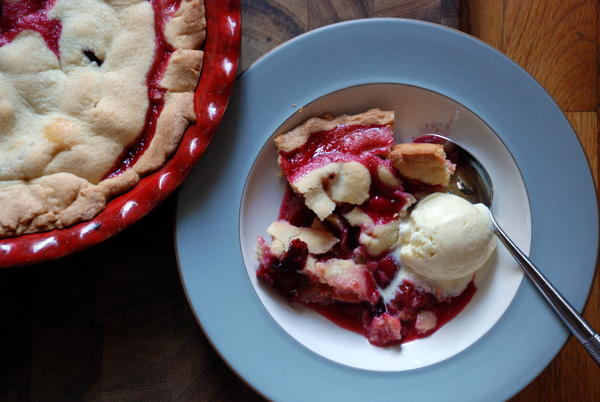I'm here to put a stake in the ground: bottom crust is not necessary. Buried under a pile of juicy summer fruit, it's only a matter of time before the crust succumbs to its inevitable, soggy fate. Purists will tell you that a pie without a bottom crust is not a pie at all, and they will soldier on, pre-baking the thing, brushing it with egg, saying a special prayer before they fill it with juice. I've done that a lot, and I'm sure I'll do it again. (Apple pie season is around the corner, gulp.) But for now, I just turn to Nigel Slater, the wonderful British food writer and cookbook author, who says with an air of authoritativeness and nonchalance that we should skip the bottom crust entirely.
That's right: one crust, laid flat over summer's juiciest, sweetest plums. It's a genius recipe, really, because it takes all the anxiety out of making such a pie. You know, that thing where you par-bake the bottom crust and it shrinks away from the sides of your pan, banishing all hopes for an elegantly-shaped pie. Or that other thing where you take your pie out of the oven and anxiously count the minutes before people are eating it, for fear that if they take too long on their main course, they'll definitely be eating mush for dessert. One-crust pies do away with those things.
As soon as you embark on making a pie that's just got a top crust, you really can make that crust however you see fit. Nigel Slater adds an egg to his crust, nudging its texture ever so slightly toward cake. The result is billowy and light, still short like pie crust but less prone to tearing or crumbling. Its as unfussy as all summer recipes should be.
The recipe comes from Ripe, Slater's homage to his fruit patch and the authoritative guide to using your summer produce. Ripe is organized by fruit, with dedicated chapters helping you work your way through damsons, elderberries (what, you don't have elderberries? For shame!) and all the usual suspects, too. He offers both savory and sweet ideas in each chapter, and I've already got several other recipes flagged for immediate attention. (Can you say blackberry semifreddo?) But this weekend, I made pie.
The pie calls for quartered plums, but it also calls for the juiciest plums you can find. In my case, those plums were too juicy to be quartered. I cut into them with a paring knife, then snipped off chunks until most of what remained was pit. I then supplemented with nectarines, because I didn't have quite enough plums to swing a full pie. Many of my plums became mush, but so be it: August plum-cutting isn't a precise science. Fret not: your juiciest, least-cooperative plums have found their delicious destiny.
Single-Crust Plum PieAdapted slightly from Nigel Slater's Ripe
7 tablespoons butter 1/2 cup sugar 1 egg, lightly beaten 1 1/3 cups all-purpose flour 1/2 teaspoon baking powder 1/4 teaspoon coarse or flaky salt a bit of milk, for brushing crust
2 pounds ripe, juicy plums (or a mix of plums and peaches/nectarines) 2 tablespoons sugar 1/8 teaspoon cinnamon (though I substituted galangal, and if you have that lying around, the combination is wonderful)
Cream the butter and sugar in a stand mixer or with an electric beater until light and fluffy, about 1 minute.
Mix in the lightly beaten egg, then gently add the flour and baking powder and mix on low speed until no streaks of flour remain. Remove dough from the mixing bowl and roll into a ball on a heavily floured work surface. Wrap in wax or parchment paper and refrigerate for about 20 minutes.
Preheat the oven to 350 degrees F.
Cut the ripe plums in half and remove their stones. Cut the fruit into whatever large pieces you can manage, then toss with the sugar and cinnamon and put into a lightly buttered pie dish.
Roll out the pastry on a floured board into a disk about 1 inch wider than the width of your pie dish, then fold in half or drape over the rolling pin and lift carefully on to the pie. There will be a little left over, and there may be a few cracks. No problem: The crust is very short, so tears are okay. If they stress you out, go ahead and patch them up. Some of the juice will probably erupt through the crust as it cooks, so we're not aiming for perfection here.
Brush the pastry lightly with milk and bake for 40-50 minutes. The pastry should be pale-biscuit coloured. Dust with sugar and serve warm with vanilla ice cream.




